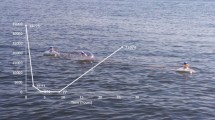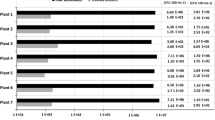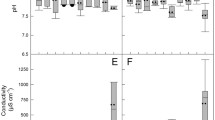Abstract
The persistence of Escherichia coli, a bacterial indicator of water quality, is relevant to assess the health risk associated with aquifer use for drinking water supplies. In order to investigate the fate of E. coli in a karst aquifer, populations of both viable and culturable E. coli were monitored, according to their settling velocities, for contrasting hydrological conditions. Solid-phase cytometry was carried out to quantify the viable E. coli, and both the genetic diversity and the resistance to antibiotics of E. coli were investigated. This study shows that: (i) at the sinkhole, the structure of the E. coli population varied with the hydrological conditions and land use; (ii) the input of E. coli strains resistant to antibiotics was linked to contamination of human origin during rainfall events; (iii) irrespective of the hydrological conditions, the karst system is a permanent reservoir of viable but non-culturable E. coli even when culturable E. coli became undetectable at the well; and (iv) following a rainfall event or during a dry period, both populations of culturable and viable but non-culturable E. coli are mainly associated with non-settleable particles, corresponding to organic or organo-mineral microflocs.
Access this chapter
Tax calculation will be finalised at checkout
Purchases are for personal use only
Similar content being viewed by others
References
Arana, I., M. Orruño, D. Pérez-Pascual, C. Seco, A. Muela, and I. Barcina. 2007. Inability of Escherichia coli to resuscitate from the viable but non culturable state. FEMS Microbiology and Ecology 62: 1–11.
Bakalowicz, M. 2005. Karst groundwater: A challenge for new resources. Hydrogeology Journal 13: 148–160.
Bartram, J., and S. Cairncross. 2010. Hygiene, sanitation, and water: Forgotten foundations of health. PLoS Medicine 7: e1000367.
Bergholz, P., J.D. Noar, and D.H. Buckley. 2011. Environmental patterns are imposed on the population structure of Escherichia coli after fecal deposition. Applied Environmental Microbiolology 77: 211–219.
Berthe, T., M. Ratajczak, O. Clermont, E. Denamur, and F. Petit. 2013. Evidence for coexistence of distinct Escherichia coli populations in various aquatic environments and their survival in estuary water. Applied and Environmental Microbiology 79: 4684–4693.
Carlos, C., M.M. Pires, N.C. Stoppe, E.M. Hachich, M.I. Sato, T.A. Gomes, L.A. Amaral, and L.M. Ottoboni. 2010. Escherichia coli phylogenetic group determination and its application in the identification of the major animal source of fecal contamination. BMC Microbiology 10: 1.
Characklis, G.W., J.D. Mackenzie, O.D. Simmons III, C.A. Likirdopulos, L.A.H. Krometis, and M.D. Sobsey. 2005. Microbial partitioning to settleable particles in stormwater. Water Research 39: 1773–1782.
Clermont, O., M. Olier, C. Hoede, L. Diancourt, S. Brisse, M. Keroudean, J. Glodt, B. Picard, E. Oswald, and E. Denamur. 2011. Animal and human pathogenic Escherichia coli strains share common genetic backgrounds. Infection Genetic Evolution 11: 654–662.
Clermont, O., J.K. Christenson, E. Denamur, and D.M. Gordon. 2013. The Clermont Escherichia coli phylo-typing method revisited: Improvement of specificity and detection of new phylo-groups: A new E. coli phylo-typing method. Environmental Microbiology Reports 5: 58–65.
Dussart-Baptista, L., N. Massei, J.-P. Dupont, and T. Jouenne. 2003. Transfer of bacteria-contaminated particles in a karst aquifer: Evolution of contaminated materials from a sinkhole to a spring. Journal of Hydrology 284: 285–295.
Fournier, M., N. Massei, M. Bakalowicz, L. Dussart-Baptista, J. Rodet, and J.-P. Dupont. 2007. Using turbidity dynamics and geochemical variability as a tool for understanding the behavior and vulnerability of a karst aquifer. Hydrogeology Journal 15: 689–704.
Garcia-Armisen, T., and P. Servais. 2009. Partitioning and fate of particle-associated E. coli in river water. Water Environmental Research 81: 21–28.
Gordon, D.M. 2010. Strain typing and the ecological structure of Escherichia coli. Journal AOAC International 93: 974–984.
Hales, S., and C. Corvalan. 2006. Public health emergency on planet Earth: Insights from the Millennium Ecosystem Assessment. EcoHealth 3: 130–135.
Ishii, S., and M.J. Sadowsky. 2008. Escherichia coli in the environment: Implications for water quality and human health. Microbiology in the Environment 23: 101–108.
Jamieson, R., D.M. Joy, H. Lee, R. Kostaschuk, and R. Gordon. 2005. Transport and deposition of sediment-associated Escherichia coli in natural streams. Water Research 39: 2665–2675.
Kaper, J.B., J.P. Nataro, and H.L.T. Mobley. 2004. Pathogenic Escherichia coli. Nature Reviews of Microbiology 2: 123–140.
Keep, N.H., J.M. Ward, G. Robertson, M. Cohen-Gonsaud, and B. Henderson. 2006. Bacterial resuscitation factors: Revival of viable but non culturable bacteria. Cell Molecular Life Science 63: 2555–2559.
Krometis, L.A.H., G.W. Characklis, O. Simmons III, J.D. Mackenzie, C.A. Likirdopulos, and M.D. Sobsey. 2007. Intra-storm variability in microbial partitioning and microbial loading rates. Water Research 41: 506–516.
Laroche, E., F. Petit, M. Fournier, and B. Pawlak. 2010. Transport of antibiotic-resistant Escherichia coli in a public rural karst water supply. Journal of Hydrology 392: 12–21.
Lemarchand, K., N. Parthuisot, P. Catala, and P. Lebaron. 2001. Comparative assessment of epifluorescence microscopy, flow cytometry and solid-phase cytometry used in the enumeration of specific bacteria in water. Aquatic Microbiology and Ecology 25: 301–309.
Magiorakos, A.-P., A. Srinivasan, R.B. Carey, Y. Carmeli, M.E. Falagas, C.G. Giske, S. Harbarth, J.F. Hindler, G. Kahlmeter, B. Olsson-Liljequist, et al. 2012. Multidrug-resistant, extensively drug-resistant and pandrug-resistant bacteria: An international expert proposal for interim standard definitions for acquired resistance. Clinical Microbiology of Infections 18: 268–281.
Mahler, B.J., J.-C. Personné, G.F. Lods, and C. Drogue. 2000. Transport of free and particulate-associated bacteria in karst. Journal of Hydrology 23: 179–193.
Massei, N., M. Lacroix, H.Q. Wang, B.J. Mahler, and J.P. Dupont. 2002. Transport of suspended solids from a karstic to an alluvial aquifer: The role of the karst/alluvium interface. Journal of Hydrology 260: 88–101.
Massei, N., H.Q. Wang, J.-P. Dupont, J. Rodet, and B. Laignel. 2003. Assessment of direct transfer and resuspension of particles during turbid floods at a karstic spring. Journal of Hydrology 275: 109–121.
Muirhead, R.W., R.P. Collins, and P.J. Bremer. 2006. Numbers and transported state of Escherichia coli in runoff direct from fresh cowpats under simulated rainfall. Letters in Applied Microbiology 42: 83–87.
Nnane, D.E., J.E. Ebdon, and D.H. Taylor. 2011. Integrated analysis of water quality parameters for cost-effective faecal pollution management in river catchments. Water Research 45: 2235–2246.
Oliver, D.J. 2010. Recent findings on the viable but non culturable state in pathogenic bacteria. FEMS Microbiology Review 34: 415–425.
Özkanca, R., F. Saribiyik, K. Isik, N. Sahin, E. Kariptas, and K.P. Flint. 2009. Resuscitation and quantification of stressed Escherichia coli K12 NCTC8797 in water samples. Microbiology Research 164: 212–220.
Pachepsky, Y.A., and D.R. Shelton. 2011. Escherichia coli and fecal coliforms in freshwater and estuarine sediments. Critical Reviews of Environmental Science and Technology 41: 1067–1110.
Page, R.M., S. Scheidler, E. Polat, P. Svoboda, and P. Huggenberger. 2012. Faecal indicator bacteria: groundwater dynamics and transport following precipitation and river water infiltration. Water, Air, and Soil pollution 223: 2771–2782.
Pronk, M., N. Goldsheider, and J. Zopfi. 2007. Particle-size distribution as indicator for fecal bacteria contamination of drinking water from karst springs. Environmental Science and Technology 41: 8400–8405.
Pronk, M., N. Goldsheider, and J. Zopfi. 2006. Dynamics and interaction of organic carbon, turbidity and bacteria in a karst aquifer system. Hydrogeology Journal 14: 473–484.
Ratajczak, M., E. Laroche, T. Berthe, O. Clermont, B. Pawlak, E. Denamur, and F. Petit. 2010. Influence of hydrological conditions on the Escherichia coli population structure in the water of a creek on a rural watershed. BMC Microbiology 10: 222.
Rozen, Y., and S. Belkin. 2001. Survival of enteric bacteria in seawater. FEMS Microbiology Reviews 25: 513–529.
Sinclair, A., D. Hebb, R. Jamieson, R. Gordon, K. Benedict, K. Fuller, G.W. Stratton, and A. Madani. 2009. Growing season surface water loading of fecal indicator organisms within a rural watershed. Water Research 43: 1199–1206.
Soupir, M.L., S. Mostaghimi, and T. Dillaha. 2010. Attachment of Escherichia coli and Enterococci to particles in runoff. Journal of Environmental Quality 39: 1019–1027.
Tenaillon, O., D. Skurnik, B. Picard, and E. Denamur. 2010. The population genetics of commensal Escherichia coli. Nature Reviews of Microbiology 8: 207–217.
Trevors, J.T. 2011. Viable but non culturable (VBNC) bacteria: Gene expression in planktonic and biofilm cells. Journal of Microbiological Methods 86: 266–273.
Van Elsas, J.D., A. Semenov, R. Costa, and J.T. Trevors. 2011. Survival of Escherichia coli in the environment: Fundamental and public health aspects. ISME Journal 5: 173–183.
Viau, E.J., K.D. Goodwin, K.M. Yamahara, B.A. Layton, L.M. Sassoudre, S.L. Burns, H.I. Tong, S.H.C. Wong, Y. Lu, and A.B. Boehm. 2011. Bacterial pathogens in Hawaiian coastal streams—Associations with fecal indicators, land cover, and water quality. Water Research 45: 3279–3290.
Vital, M., F. Hammes, and T. Egli. 2008. Escherichia coli O157 grow in natural freshwater at low carbon concentration. Environmental Microbiology 10: 2387–2396.
Vital, M., F. Hammes, and T. Egli. 2012. Competition of Escherichia coli O157 with a drinking water bacterial community at low nutrient concentrations. Water Research 46: 6279–6290.
Walk, S.T., E.W. Alm, D.M. Gordon, J.L. Ram, G.A. Toranzos, J.M. Tiedje, and T.S. Whittam. 2009. Cryptic lineages of the genus Escherichia. Applied and Environmental Microbiology 75: 6534–6544.
Acknowledgements
This study was based in part on the thesis work of Mehdy Ratajczak and Emilie Laroche. The authors thank Julie Gonand and Florian Van Dooren for technical assistance and Professor Robert Lafite for the settling experiments. This work was supported by the National Water Agency Seine Normandie and the Research Federation FR CNRS SCALE.
Author information
Authors and Affiliations
Corresponding author
Editor information
Editors and Affiliations
Rights and permissions
Copyright information
© 2018 Springer International Publishing AG
About this paper
Cite this paper
Petit, F. et al. (2018). Factors Influencing the Occurrence and the Fate of E. coli Population in Karst Hydrosystems. In: White, W., Herman, J., Herman, E., Rutigliano, M. (eds) Karst Groundwater Contamination and Public Health. Advances in Karst Science. Springer, Cham. https://doi.org/10.1007/978-3-319-51070-5_25
Download citation
DOI: https://doi.org/10.1007/978-3-319-51070-5_25
Published:
Publisher Name: Springer, Cham
Print ISBN: 978-3-319-51069-9
Online ISBN: 978-3-319-51070-5
eBook Packages: Earth and Environmental ScienceEarth and Environmental Science (R0)




